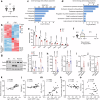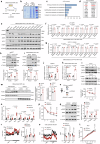Sortilin-mediated translocation of mitochondrial ACSL1 impairs adipocyte thermogenesis and energy expenditure in male mice
- PMID: 39232011
- PMCID: PMC11374900
- DOI: 10.1038/s41467-024-52218-4
Sortilin-mediated translocation of mitochondrial ACSL1 impairs adipocyte thermogenesis and energy expenditure in male mice
Abstract
Beige fat activation involves a fuel switch to fatty acid oxidation following chronic cold adaptation. Mitochondrial acyl-CoA synthetase long-chain family member 1 (ACSL1) localizes in the mitochondria and plays a key role in fatty acid oxidation; however, the regulatory mechanism of the subcellular localization remains poorly understood. Here, we identify an endosomal trafficking component sortilin (encoded by Sort1) in adipose tissues that shows dynamic expression during beige fat activation and facilitates the translocation of ACSL1 from the mitochondria to the endolysosomal pathway for degradation. Depletion of sortilin in adipocytes results in an increase of mitochondrial ACSL1 and the activation of AMPK/PGC1α signaling, thereby activating beige fat and preventing high-fat diet (HFD)-induced obesity and insulin resistance. Collectively, our findings indicate that sortilin controls adipose tissue fatty acid oxidation by substrate fuel selection during beige fat activation and provides a potential targeted approach for the treatment of metabolic diseases.
© 2024. The Author(s).
Conflict of interest statement
The authors declare no competing interests.
Figures







References
Publication types
MeSH terms
Substances
Associated data
Grants and funding
- 82350610277/National Natural Science Foundation of China (National Science Foundation of China)
- 82070859/National Natural Science Foundation of China (National Science Foundation of China)
- 82270910/National Natural Science Foundation of China (National Science Foundation of China)
- R01 DK133948/DK/NIDDK NIH HHS/United States
- P30 DK135043/DK/NIDDK NIH HHS/United States
LinkOut - more resources
Full Text Sources
Molecular Biology Databases
Miscellaneous

